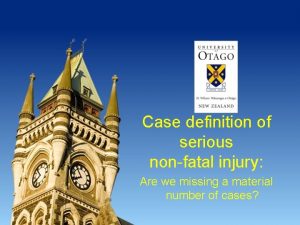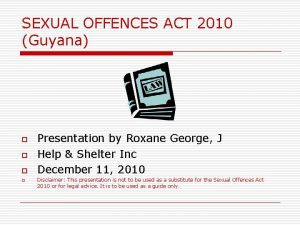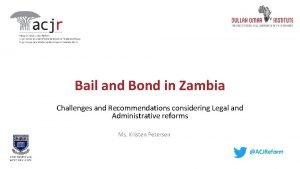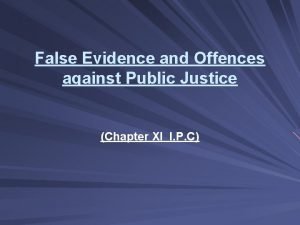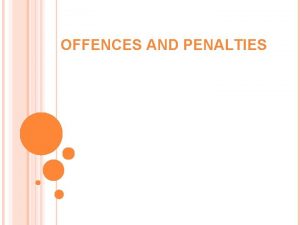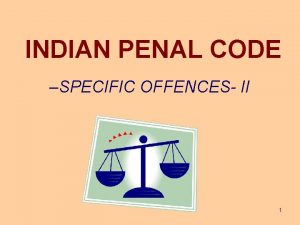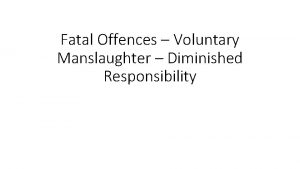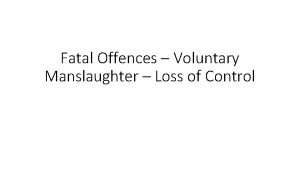Evaluation of Fatal Offences Exam question on evaluation

















- Slides: 17

Evaluation of Fatal Offences

Exam question on evaluation of fatal offences • Despite some recent reforms, there are still criticisms to be made of the current law on murder and voluntary manslaughter. Consider relevant criticisms of that law and consider any reforms that might be available (25) • Write a critical analysis of the law on murder and voluntary manslaughter. Discuss any reforms that may be desirable (25) • 3 potential contents: • Criticisms of murder • Criticisms of voluntary manslaughter • Reforms • What to do in questions: • • Outline relevant current law Discuss strengths and weaknesses in law Identify proposals for reform Discuss how these proposals would improve the law

Evaluation of Murder • Criticisms of murder 1. Express/implied intent 2. Direct/indirect intent 3. Mandatory life sentence

1. Implied Intent - cause serious bodily harm • A person who intends to cause serious bodily harm and actually causes his victim’s death is guilty of murder • Should a D whose only intention is to cause serious bodily harm be as guilty of murder as one who deliberately sets out to kill? • What about a D whose main intention isn’t even to cause serious bodily harm? • In Hancock and Shankland, Ds argued their intention had been to block the road when they threw the concrete slab from the bridge

1. Criticism of Implied Malice • Vickers confirmed that intention to cause GHB amounts to intention for murder • Grievous is interpreted as “serious harm that does not have to be life threatening” • Cheshire – victim died of medical complications following the initial wound which was not in itself life threatening. • Murder conviction leads to mandatory life sentence and arguably this should be reserved solely for those who intend to kill • Implied malice rule has been criticised by many judges and legal writers as it is argued it extends the definition of murder too far – it is hard to justify because the fault element (intention to cause GBH) does not correspond to the consequences (death of victim) • No premeditation required for murder – intent to kill can arise in the heat of the moment

2. Suggested Reform on Implied Intent • Often been suggested that law on murder be codified so that it is included in new legislation • Draft Criminal Code produced in 1989 proposed this definition of the intention for murder: • Intending to cause death • Intending to cause serious personal harm and being aware that he may cause death • D would only be found guilty if jury was sure that D was aware his action could cause death • But no attempt has been made to codify the law in this way

2. Intent – Indirect Intent - Foresight of Consequences • Has been a confusing situation in defining foresight of consequences • In Woollin – held that foresight of consequences amounts to intention • In Matthews and Alleyne – held that foresight of consequences is a rule of evidence so jury is entitled to find intention but is not obliged to do so

2. Suggested Reform • Law Commission is its report – Offences Against the Person and General Principles (1993) proposed the word intentionally should be defined as: • It is his purpose to cause the result; or • Although it is not his intention to cause the result, he knows that it would occur in the ordinary course of events if he were to succeed in his purpose of causing some other result • This would clarify the position on foresight of consequences and intent

3. Mandatory Life Sentence • Murder (Abolition of the Death Penalty) Act 1965 • Reasoning – murder is generally held to be the most dreadful of crimes and deserves the maximum sentence permitted by law • Also an element of appeasing those who opposed the abolition of the death penalty • Applies to any person over the age of 18 • When passing the sentence judge must decide on the tariff – length of time D must serve in prison as a minimum before being considered for release • Length of tariff depends on particular factors of the crime – e. g. whether it was racially motivated or had a sexual element • Once D has served minimum time under the tariff he may be released but under licence which means he can be made to return to prison if he doesn’t comply with the terms of his release – so sentence remains even when D is no longer in prison • In some cases, judge can order a whole of life sentence – D will never be released • Person between 10 and 17 is “detained at Her Majesty’s pleasure” – indefinitely until such a time as it is deemed safe to return him to society

3. Criticisms of Mandatory Life Sentence • No flexibility for judge to vary sentence according to seriousness of the killing: • Murders cover varying degrees of seriousness – e. g. cold-blooded serial killers such as Sutcliffe or the Wests, or those who kill from motives of compassion (mercy killers), or those like Anthony Martin who overstep the limits of reasonable force in self-defence • In order to avoid the Mandatory Life Sentence, inappropriate verdicts of manslaughter may be returned – e. g. in cases of “mercy killings” where defence of diminished responsibility has been accepted with the flimsiest of evidence • If life imprisonment does not usually mean for life then why call it life imprisonment and insist on it being passed?

3. Suggested Reform • Abolish mandatory life sentence and make it discretionary – other crimes like manslaughter, rape, wounding with intent, attempted murder all have a maximum of life imprisonment but it is discretionary • Judge would have the flexibility to impose life (meaning for life) for the most serious murders, and for other killings could impose a term of years reflecting their seriousness • Different degrees of murder could be introduced, as in the USA • Most serious murders would attract mandatory life sentence and less serious ones would attract discretionary life sentences

Evaluation of Voluntary Manslaughter – Loss of Control • Coroners and Justice Act 2009 abolished the much criticised defence of provocation and replaced it with the defence of loss of control • Requires D to prove loss of control from a qualifying trigger • When evaluating Lo. C, generally need to consider: • What problems were in the old law of provocation • How the new law tries to rectify this • What problems remain • 2 main issues: • Fear trigger – Fear of serious violence • Anger trigger – Things done or said…

1. Fear trigger - Fear of Serious Violence • Under law of provocation, had to be a sudden and temporary loss of control • Created a problem – women who were being abused could often not use the defence - women are usually physically weaker than men and less likely to react straight away when attacked by a violent partner but if there was a time lapse, they could not show the loss of control was sudden and temporary • New law of Lo. C - First qualifying trigger of “fear of serious violence” attempts to address the problem faced by women who kill their partners after suffering abuse by them • In Ahluwalia D waited until husband was asleep and defence of provocation would not have been available to her • Removal of suddenness requirement is a positive change as is the recognition that killing through fear is as justified as killing through anger • But – still a requirement that to lose self-control based on fear, and this may be difficult to prove as people do not typically lose self-control when afraid

1. Suggested Reform for Fear Trigger • Law Commission suggests - remove the need for loss of self-control in relation to fear of serious violence – to protect abused women more adequately • This means defence could be pleaded where D acts our of fear of serious violence without needing to prove a loss of self-control

2 and 3. Anger trigger - Things Done or Said… • Criticism of defence of provocation was that almost any words or conduct could be considered to have provoked D to kill – e. g. Doughty – crying baby was said to amount to provocation • New law of Lo. C - Qualifying triggers prevent such situations • S. 55 Coroners and Justice Act 2009 applies if D’s loss of control was attributable to things said or done which constituted circumstances of an extremely grave character and caused D to have a justifiable sense of being seriously wronged. Now the test is objective – situation in Doughty would not now be covered by the partial defence • Old Law of provocation – allowed sexual infidelity to amount to provocation • S. 55 excludes sexual infidelity from contributing to a qualifying trigger • Parliament excluded sexual infidelity to prevent situations where men were provided with an excuse for killing an unfaithful partner and being treated more leniently – killing an unfaithful partner would always be classed as murder • But – defining what is meant by sexual infidelity is problematic • Clinton – allowed the defence to be put to the jury as sexual infidelity was only part of the reason for D’s loss of control – this precedent dilutes the provision as in many cases the sexual infidelity is likely to be part of the context rather than the only factor so there are questions as to whether the judges really followed the intentions of Parliament in this case • Also there is an argument that sexual infidelity is one of the most likely causes for someone losing their self-control and therefore should not have been excluded in the first place

2 and 3. Suggested Reform for Anger Trigger • Sexual infidelity exception may need to be removed or revised in light of the decision in Clinton • Some argue the 2 nd trigger should be abolished altogether as there can be no excuse for killing in anger • In New Zealand, following a case where a man stabbed his girlfriend over 200 times, claiming she had provoked him, the Government decided to abolish the defence of provocation altogether. Justice Minister of NZ said it provides a defence for lashing out in anger and “violent homicidal rage”. It “rewards lack of self-control by enabling intentional killing to be categorised as something other than murder” • Some critics in the UK argue that the 1 st qualifying trigger should be retained but the 2 nd should be withdrawn

Reclassification of Homicide – Law Commission Report 2006 – Proposals • First degree murder (mandatory life sentence): • Intentional killing; or • Killing with intent to cause serious injury, in the awareness there is a serious risk of causing death • Second degree murder (discretionary life sentence): • Killing with intent to do serious injury • Killing with intent to cause some injury or fear or risk of injury, in the awareness that there is a serious risk of causing death • Killing with the intent for first degree murder but where a defence of loss of control, diminished responsibility or suicide pact succeeds • Manslaughter (discretionary life sentence) – cover the different types of involuntary manslaughter that currently exists • Law Commission suggests that this three-tier structure of homicide would “give the jury in homicide trials greater power to reflect in their verdict the extent to which the offender was at fault in killing • No action has been taken on these proposals
 Evaluation of non fatal offences
Evaluation of non fatal offences Jcc v eisenhower
Jcc v eisenhower Non-fatal injury evaluation
Non-fatal injury evaluation Level three questions
Level three questions Guyana sexual offences act
Guyana sexual offences act Fia schedule offences
Fia schedule offences Pharmaceutical society of great britain v storkwain
Pharmaceutical society of great britain v storkwain Common offences against animals
Common offences against animals Non bailable offences in zambia
Non bailable offences in zambia False evidence and offences against public justice
False evidence and offences against public justice Callow v tillstone
Callow v tillstone Catamite definition
Catamite definition Cybercrime offences inverness
Cybercrime offences inverness Young and dyslexic summary
Young and dyslexic summary War photographer textual analysis
War photographer textual analysis Security architecture for systems engineer sase 500 651
Security architecture for systems engineer sase 500 651 Slidetodoc.com
Slidetodoc.com What is the poem the bright lights of sarajevo about
What is the poem the bright lights of sarajevo about


